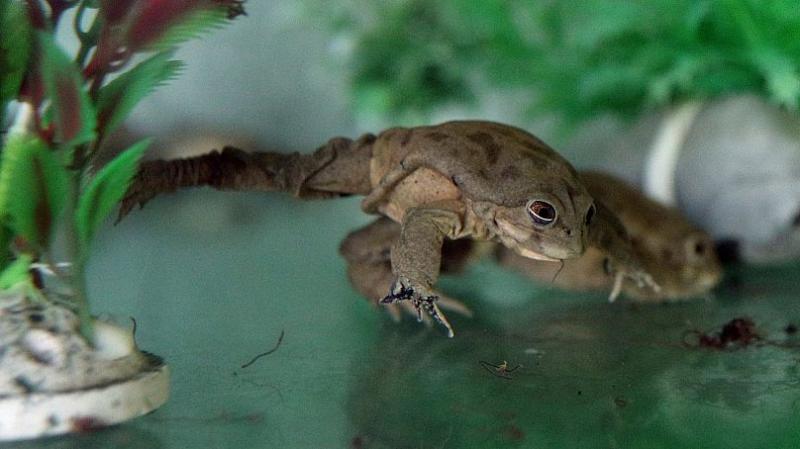‘Climate captives’: The wins and losses of 2023’s threatened species list
Just over 44,000 species are threatened with extinction - around 2,000 more than last year - according to the latest Red List of Threatened Species.
A tracker of biodiversity around the globe, the report was released by the International Union for Conservation of Nature (IUCN) at COP28 in Dubai on Monday.
It was mainly bad news. This year's list includes information on 157,000 species, about 7,000 more than last year's update.
It shows how climate change is worsening the planet's biodiversity crises, making environments more deadly for thousands of species and accelerating the precipitous decline in the number of plants and animals on Earth.
“Species around the world are under huge pressure. So no matter where you look, the numbers of threatened species are rising,” says Craig Hilton-Taylor, head of the Red List unit at the IUCN, an international organisation that tracks species' health.
A captive frog, of the Telmatobius Culeus species, moves inside of a glass box at Huachipa Zoo, on the outskirts of Lima, Peru, 6 November 2019.AP Photo/Martin Mejia, FileWhich species are now on the IUCN Red List?
Climate change is worsening conditions for about 6,700 species threatened with extinction.
Species of salmon and turtles are among those facing a decline as the planet warms.
The Central South Pacific and East Pacific green turtle is at greater risk because of climate change, for example. Fewer turtles hatch as higher seas inundate nests. Warming waters can harm its food supply of seagrasses.
- How are green corridors saving one of Brazil’s most endangered species from deforestation?
- ‘More precious than gold’: How a long lost mole was rediscovered with the help of a border collie
Atlantic salmon isn’t yet threatened with extinction, but its population dropped by nearly a quarter from 2006 to 2020, according to the IUCN. It’s now considered near threatened.
The fish live in fewer places and face human-created hazards like dams and water pollution. Climate change is making it harder for them to find food and easier for alien species to compete, according to the group. There are some signs of hope: their numbers ticked up in Maine, US, this past year.
Green sea turtles (Chelonia mydas) make their way into the ocean upon their release at Kuta beach, Bali, Indonesia, 8 January 2022.AP Photo/Firdia Lisnawati, FileOne-quarter of freshwater fish species face extinction risk
The update includes the first broad assessment of the health of freshwater fish species. One-quarter of species - just over 3,000 - face an extinction risk.
As climate change raises sea levels, salt water is traveling further up rivers. And these species already face tremendous threats from pollution and overfishing, the IUCN says.
Frogs, salamanders and other amphibians are suffering the most. About 41 per cent of these species are under threat.
“They are climate captives because of higher temperatures, drought - whatever happens amphibians cannot move out of harm's way and are directly impacted by climate change,” says Vivek Menon, deputy chair of the IUCN's species survival commission.
A researcher holds a Coqui Guajon or Rock Frog (Eleutherodactylus cooki) at a tropical forest in Patillas, Puerto Rico on 21 March 2013.AP Photo/Ricardo Arduengo, FileWhich species are returning from the brink of extinction?
There was a bit of good news. Two antelope species are fairing better, although they still have a long way to go before their long-term survival is stabilised.
For example, the scimitar-horned oryx, a light-coloured animal with curved horns, had previously been categorised as extinct in the wild but is now endangered. It faced a lot of threats: poaching, drought and car accidents all played a role in largely eliminating the species by the turn of the century.
But recent efforts to reintroduce the species in Chad have helped and there are now at least 140 adults and more than twice as many calves on a large nature reserve.
IUCN's director general Grethel Aguilar says it's clear humans need to act to protect biodiversity and when conservation is done right, it works. To combat the threat posed by climate change, she says fossil fuels need to be phased out, a contentious focus of this year's COP28 negotiations.
ADVERTISEMENT“Nature is here to help us, so let us help it back," she says.
منبع خبر: یورو نیوز ![]()
اخبار مرتبط: ‘Climate captives’: The wins and losses of 2023’s threatened species list
حق کپی © ۲۰۰۱-۲۰۲۴ - Sarkhat.com - درباره سرخط - آرشیو اخبار - جدول لیگ برتر ایران

